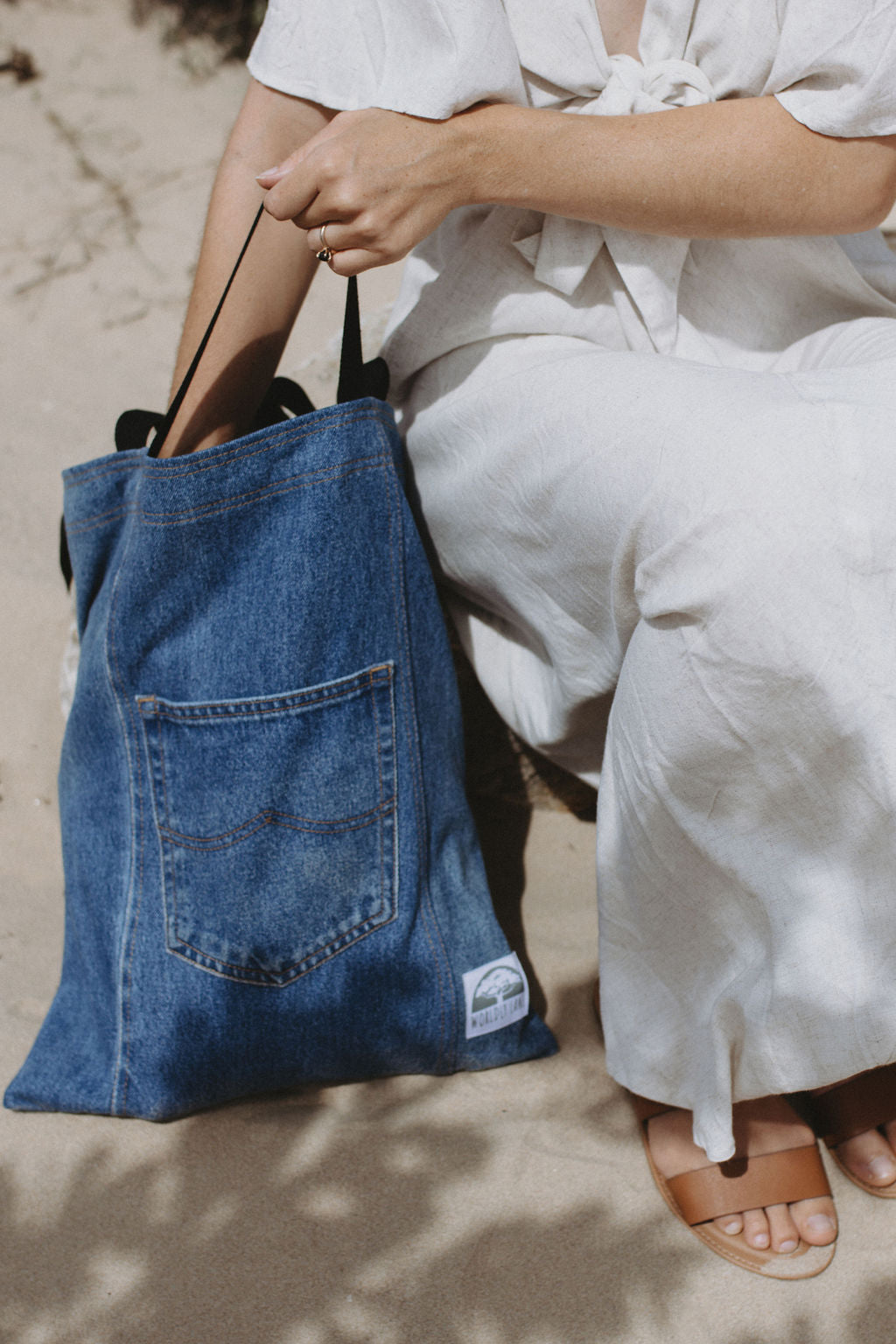Nowadays, from getting your groceries to designer products, you’re destined to encounter an offer for a cotton bag (a common trend nowadays is that they are as cheap as a dollar)/you might already be carrying one yourself, or have it somehow already incorporated within the packaging of the product. This level of accessibility has led to countless bags being produced, acquired and store within our homes, cars, bikes etc. So how did we get here? In short, when the world discovered that plastic bags were filling our oceans, killing our marine life and contributing to endless landfill, something had to be done. We turned our attention, to the cotton bag, which wasn’t a new concept, but something that could be reused rather a single use item and was made to last (in most cases). In combination, with the help of the fashion industry, the cotton bag quickly became a popular accessory to hit the streets. The bags flexibly in designs and colours, lead to it an easy sell and marketing exercise for business, as well with the environmental friendly perceptions, created a catalyst event for us as consumer an owning endless supply of bags.

Prior to the pandemic in 2018, there was a flood of articles and discussion following the publication from the Danish Government (Environmental Protection Agency) on the Life Cycle Assessment (LCA) of grocery bags found within typical European supermarkets. The findings were alarming, as it highlighted how a plastic bag was a better use for the environment, in a sense that it would require a single reuse to offset its carbon footprint. On the other hand cotton bags and their organic counterpart, would need to be reused at least 7,100 times (for a cotton bag) and 20,000 times (for an organic cotton). Now before, you stop reading and go and throw out all of your cotton bags, please continue reading as we will unpack these numbers and assumptions to highlight our take of the assessment.
How are bags produced?
To begin with, let’s first unpack how these bags are produced. The process of cotton production is generally described as a labour intensive process, which requires a generous supply of land and water availability. The process begins with seeds planted and cared for through experienced farming practice, watering techniques, pesticides and fertilisers (organic cotton does not contain any). The crop is grown until cotton balls form, which are the little white fluffy balls. From there, they are harvested and then processed through a term called ginning, where it removes the dirt, stems and leaves, to have the fibre and seeds. The fibre (lint) is then compressed into bales, to then be transferred to textile mills and be converted into fabric. Whereas to develop plastic bags most of the energy begins at the raw extraction of non renewable resources such as crude oil/petroleum or gas. From there it is treated and undergoes polymerisation, to transfer it into granules (little ball shaped objects). Often the granules get transferred to another facility to undergo a heating process to be melted into thin film which is cut or shaped as needed.

Life cycle of the two bags
After learning how plastic and cotton are made, have the Danish lost their mind, or are they onto something? LCA typically cover the resources, technology and energy used to generate the item, it’s intended use, life span and lastly the waste management and disposal processes. With that in mind, how do the two differ within the overall life cycle?
- For starters key differences begin in transportation. Plastic bags have been identified to be lighter and less dense than cotton, meaning during transportation vehicles can carry more stock, whereas cotton bags can be heavier and cost more to transport.
- Cotton bags often undergo a branding process with the use of inks, chemicals etc. Depending on the information provided and the business, most of the inks used are extremely difficult to break down, as well should you wish to recycle it can be difficult (some advice is to cut the logo out for the waste bin and to either upcycle or possibly compost the cotton bag). Plastic bags can also undergo this process, however, are often not recycled, but just reused as a waste bin. This was seen as an easier outcome for the assessment.
- The report talks about how plastic breaks down quicker due to breaking apart into microplastics. That is considered favourable within the disposal methodology of the LCA.
- It’s estimated that globally, cotton farming takes up 3% of farmland, but only 33% of the harvested yield can be used.
- Cotton is responsible for 25% of the world’s pesticide usage The use of fertiliser can add to this as well as the fossil fuel takes to run the harvesting and ginning process.
- The report identifies that organic cotton can produce a lower yield due to the absence of these chemicals and in comparison, require more resources, water and land to produce the same yield as regular cotton.
- General upkeep for the cotton bag was considered as well, the amount of water and resources used to wash and clean the bag (although we have never really washed a cotton bag that often).

Limitations
Acknowledging the LCA and its findings, we would like to emphasise that every study has limitations. The below limitations have been identified from the assessment and LCA studies in general.
1. Assumptions
There were several knowledge gaps within the Danish assessment, and therefore were based off estimations due to the lack of available information within supply chains. Due to the complexity of an LCA this is often the case. These assumptions can cause some of the numbers such as minimum uses for carbon offset, to be higher than it should, which at times can be misrepresented within media or public perceptions. Furthermore, LCA require large dataset which often already contain a number of generalisations, causing further analysis of these figures to be more generalised rather than specific findings.
Due to the primary purpose of this study was looking at bags found within Danish Grocery Stores, cotton bags were doubled to ensure that the volume was consistent with the other bags assessed. So, going back to that 20,000 figure, the total offset is now halved, to be 10,000 uses. In addition to this, the number of reuse is given from considering all categories, but if we remove ozone depletion this causes the number of reuses to drop to 50 from 1,400 for cotton bags and to 150 from 3,800 for organic cotton bags. While the article provides little discussion around ozone depletion, the main cause for this in the production process of cotton bags is the electricity used for irrigation (which is assumed most likely to be from gas). While we are not saying ozone depletion is a good thing and should be ignored, future assumptions can be made for a combination of part solar or renewable uses to supply power, which would significantly reduce the bags overall impact onto the planet. This can be seen as an opportunity for further investment into renewable energy for farming practices.
2. Waste Management
The assessment considers two elements of waste management, recycling, and incineration. It seems to fail to recognise the importance of litter and its effects onto the environment. As we all know, plastic bags or parts of it often end up in oceans, landfill or littering our streets. In Africa, plastic bags litter can become breeding grounds for malaria, as small bodies of water collect within these bags and mosquitoes then breed within that water. Given that plastic can break into microplastics and its takes years and years to break down, where in comparison cotton naturally breaks down, this would significantly impact its assessment and number of uses to offset its carbon footprint.

3. General word of warning
Many professionals tend to draw cautious statements around drawing conclusions from LCA studies. In addition to the above limitations, each LCA is individual to a specific region and supply chains. This causes for a lack of baseline assumptions and can lead to difficulties in comparing studies
Wrap Up
The purpose of an LCA in our opinion, is that it’s a useful tool to understand the impacts and process to generating a product. For example, from this analysis an improvement to the cotton bag process, could be to convert some or all of the irrigation, harvesting and ginning to renewable energy sources. Although with that in mind, LCA are only one part of the puzzle and should never be taken alone for the sole truth. Cotton tote bags are a useful resource to reducing consumer behaviours and further a culture away from a single use society.
At Worldly Lane, we always promote reusable quality items over any single use item. We always seek to empower our community to consider the need before purchasing, and to raise awareness to the resources required to develop an item. So, where to from here, we think it would be a great idea to share this article to a family member, friend or colleague, to help raise awareness for the resources required to develop a bag and to stimulate conversation. As always, we’d be happy to address any questions or update the journal as need be.
P.S – Watch this space, as we have something very exciting to announce
References
https://www.nytimes.com/2021/08/24/style/cotton-totes-climate-crisis.html
https://qz.com/1585027/when-it-comes-to-climate-change-cotton-totes-might-be-worse-than-plastic
https://lifehacker.com/your-cotton-tote-bags-are-totally-fine-1847585502
https://www.refinery29.com/en-au/canvas-tote-bag-sustainability-crisis
https://news.climate.columbia.edu/2020/04/30/plastic-paper-cotton-bags/
http://www.designlife-cycle.com/canvas-shopping-bags
Plastic underwater photo by Naja Bertolt Jensen on Unsplash
Cotton harvester photo by Karl Wiggers on Unsplash
Oil rig photo by Kevin Harris on Unsplash
Woman holding cotton tote bag photo by Soragrit Wongsa on Unsplash




Leave a comment
This site is protected by reCAPTCHA and the Google Privacy Policy and Terms of Service apply.